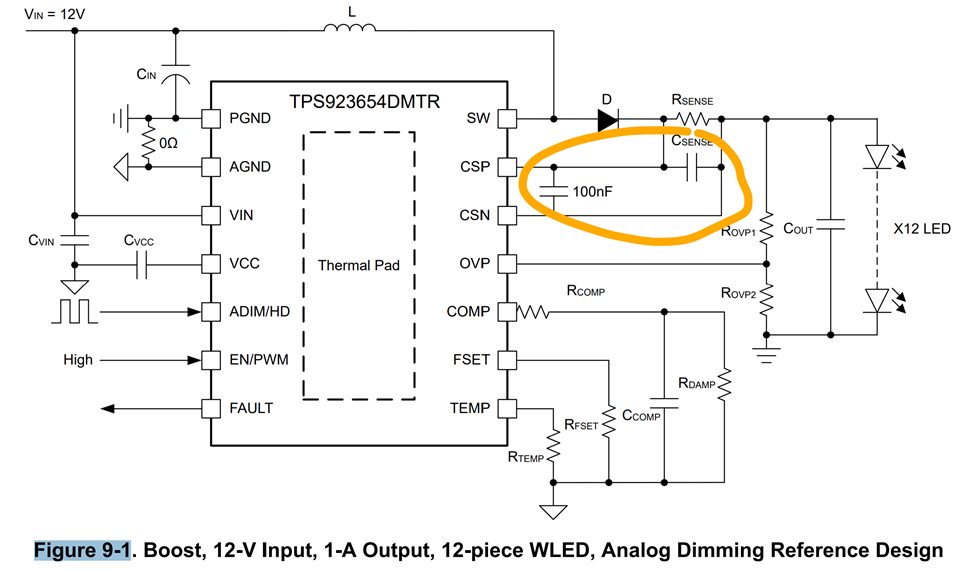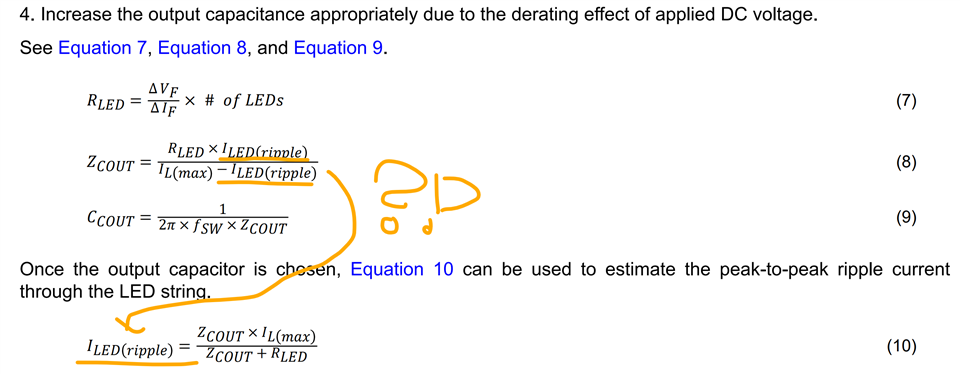Tool/software:
I try to calculate the values of required external resistors and capacitors using equations from the tps923653.pdf dated September 2023.
1. Figure 9-1 shows CSENSE capacitor in parallel with another 100nF capacitor. Is this diagram correct?
The reason why I ask it because it seems that section 9.2.1.2.5 "Other External Components Selection" may be describing two different capacitors, with two different functions while on the Figure 9-1 both capacitors are in parallel configuration. Why use two capacitors? Is it to reduce ESR? In any case it is a bit confusing. Are two capacitors really required? Please clarify.
2. In the equation (8) ILED(ripple) is used but then in equation (10) it is calculated. Likely it is a mistake. Maybe in equation (8) ILED(max) should be used instead?
ILED(max) does not appear to be used at all while probably it should be.

Maybe the answer to the above question is in this sentence: "KIND is a coefficient that represents the amount of inductor ripple current relative to the maximum LED current".
OK, but it appears that in order to calculate max inductor ripple current to select the right inductor I need to know this inductor ripple current first.
3. Equation (10) in section 9.2.1.2.3 "Output Capacitor Selection" does not contain the value of the chosen capacitor while it probably should. Likely it is a mistake. Please clarify.

4. I am not certain that I correctly understand section 8.3.3 "Undervoltage Lockout". Do I need to connect VCC pin to a resistor divider for it to work and select resistors such that VCC is above 3.2 V(typ)? But the same time VCC pin seems to be the output of the internal LDO 5.15 V(typ).
5. How do I practically calculate Rovp1 and Rovp2 to implement OVP? Let's say I want to make sure that no matter what voltage in the provided example does not go above 40V, even if LEDs get disconnected. Do I correctly assume that Rovp1 and Rovp2 have to be selected such as at 40V output OVP is 1.1 V. "Detailed Design Procedure" (section 9.2.1.2) does not explain that. E.g. how to ensure that the device does not start until Vin > 10V?
6. All I need is just a simple 'analog' dimming but I also need to be able to turn LEDs off completely. Is it enough for that to simply stop PWM at ADIM pin or need to pull EN pin down as well?
7. TPS923653 is said to be working from Vin > 4.5 V but internal LDO provides 5.15 V(typ). I just want to double check that Vin = 5V is OK.



